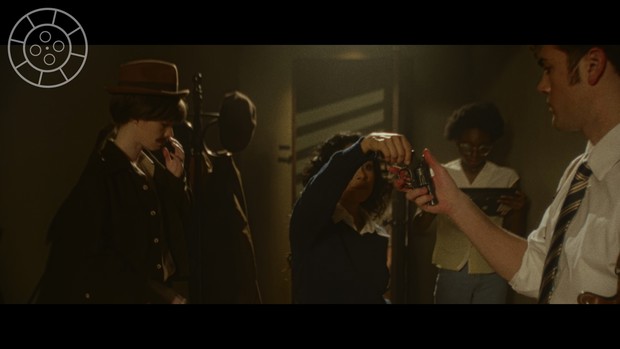Immortality review – FMV thriller from Her Story creator sure to leave a lasting impression

- 1 Comment
One daunting goal for any game designer is ensuring the player experiences the story as intended while affording them enough agency to experience it at their own pace. Immortality is the third interactive film by Sam Barlow, following Her Story and Telling Lies, the common thread between them being that their narratives are pieced together nonchronologically at the behest of the player. Much like shuffling a deck of cards, no two players will experience these games in the same order, with just a few major reveals held back until a majority of their respective tales have been told. More ambitiously than its predecessors, Immortality successfully manages to tell several stories all at once. While the audience for the stories themselves may be somewhat limited due to the nature of the material, the game as a whole is another impressive achievement of game design in filmmaking.
Immortality’s conceit is that you have been given lost film footage of the actress Marissa Marcel. Over the span of about thirty years, she made only three movies (none of which were released) and then she disappeared. Your job is to comb through two hundred clips and ten hours of film in the hope of finding clues to discover what happened to her. The first clip you watch (and the only one available) is of Marissa being interviewed on a late-night talk show about the yet-to-be-released first movie. The framework for this interactive restoration, as the game describes it, “emulates the Moviola machines that would have been used to review this footage originally.”
Most clips are a few minutes long and are a combination of actual film footage, rehearsals, table readings, and cast interviews. Each clip can be “scrubbed” frame by frame to help you identify hotspots within them, so when watching a video you can pause and then click on any number of things in the background to launch a different clip with a similar shape or theme (though not always from the same movie). For example, click on an apple in one scene, and you will likely pull up another scene where an apple (or perhaps another fruit) is prominent. Or click on Marissa herself and you will see a random clip featuring her. A particular video could start anywhere from the beginning to the end of the clip, but it’s a breeze to fast-forward and rewind so you can start watching wherever you like.

Gameplay proceeds as such, jumping between the three movies while trying to piece together each film and the mystery that is Marissa’s disappearance. Each film you watch and image you identify remains accessible via a menu that you can filter by clip number, film date, film project, or ones you’ve personally favorited. Frustratingly, the filter system is not intuitive and there is no tutorial on how to use it. Even after finishing the game I remain dumbfounded by it. Making progress is still fairly simple anyway, but it would be much smoother if the filter system were easier to master.
For the first few hours of play, a majority of the scenes you jump to will be new. However, the more you see the more you repeat. One can quickly find another hotspot to click without rewatching the same scene, though at times rewatching or scrubbing the same video repeatedly is necessary to find hotspots of unseen clips.
In watching these clips come together, it’s clear that Barlow has come into his own as a director, ironically in a way that makes it appear that he has not. A synopsis of each film is as follows:
Ambrosio: An adaptation of M.G. Lewis’s Gothic novel The Monk. Marisa plays Matilda
Minsky: Marissa plays muse to a famous artist and is suspected of his murder
Two of Everything: Marissa stars as a successful pop star and her body double who catch the eye of a rich power couple in New York City
All three movies are given the appearance of low-budget films, including the occasional boom mic being visible or the cheap costume design. By necessity, the actors are required to act as though they are being given mediocre direction. This could have easily come off as campy, but I never once felt like the actors weren’t being completely earnest. Unlike the fictional director of these films, Barlow himself elicits believable performances from top to bottom, even including the guys who just operate the clapperboard. But the star is Manon Gage, who gives quite the performance as Marissa and four of her distinct characters across the three films.
Your enjoyment of the experience will naturally depend on your patience with the nonchronological format, but the subject matter will play a part as well. A prominent content warning lets you know you’re about to witness cursing, chemical use, nudity, sex, blood, suicide, abusive relationships, sexual assault, and murder. And boy is that warning not kidding. While the fecundity of R-rated material is on par with, say, Game of Thrones, the abuse and sexual assault is especially frequent and disturbing to the point that I needed breaks to ground myself. The game also warns about “blasphemy” of the Catholic faith, and indeed much of the emotional weight here relies on not only the understanding of Christian mythology but also an interest in it. This is to the game’s detriment, however, because neither applied to me, and thus I found myself feeling quite ambivalent about Marissa’s fate.
That’s not to say I didn’t enjoy myself. The Minsky film is particularly engaging, thanks in part due to Ty Molbak, who as the detective investigating the artist’s murder is eminently charming and has great rapport with Gage. There is also a meta game, as it were, which players should discover on their own (and rather easily) over the course of play. It’s not necessary to find it to reach the end, but it certainly enhances the mystery and comes with quite a few spine-tingling moments. Despite my earlier ambivalence about what happened to Marissa, I must admit that when the reveal occurred I was shaken up a bit, not just from the revelation but from all the unanswered questions I now had.
One can reach this ending after about nine hours of play and not too much monotony. However, if you want to see every clip the game has to offer, know that at least some of the questions you still have will not be answered, and be prepared to suffer from some boredom and tendinitis as you click hotspot after hotspot, desperate to find a segment you haven’t seen before. I was around 140 or 150 clips when I “solved” the mystery, but it’s hard to tell what the exact trigger is, because it happened without any suspense to indicate I might be reaching the ending. So arriving at this point felt less like an accomplishment than a reward for clicking on anything and everything, unlike with Her Story, where I felt like I’d earned it by using deduction. After that it took me close to six hours to find the remaining footage, even with a walkthrough handy. And while some of the individual clips were interesting, I learned little more about the story.
Final Verdict
I was in near-constant awe of the impressive amount of work that went into making Immortality, and it’s certainly the most technically impressive full-motion video game I’ve ever seen. Cinephiles (especially fans of David Lynch, whose style is modeled here) should adore it, and for those interested in Christian mythology there’s a lot here to dive into. Fans of Barlow’s previous offerings and nonchronological storytelling will also likely enjoy themselves, although those looking for a straightforward mystery or concrete puzzle-solving may want to steer clear, as well as those who may be disturbed by suicide or realistic and repeated depictions of sexual assault. All in all, I found Immortality to be a finely polished and ambitious piece of art. And while the choice of subject matter means I have little desire to see it again, I am glad I did and hope it inspires future designers (and Sam Barlow himself) to continue pushing the boundaries of video game storytelling.
Hot take
While it’s hindered slightly by some questionable game design and content choices, Immortality is an otherwise impressive achievement in filmmaking and gaming with a thought-provoking and chilling story that will leave you thinking about it long after it’s over.
Pros
- Superb film work, with engaging actors and topflight directing intended to evoke B-movie Hollywood productions
- Excellent pacing leading up to the story’s climax
- Scrubbing video clips for content is simple and flawlessly executed
Cons
- Filtering already-watched clips is unintuitive and comes with no tutorial
- Once the climax is reached, seeing the rest of the content is needlessly difficult and monotonous
- Certain story themes and graphic content may put off some players
Beau played Immortality on PC using a review code provided by the game's publisher.

- Advertisement
- Help support AGH by advertising with us











1 Comment
Want to join the discussion? Leave a comment as guest, sign in or register.
Thanks for the review. This sounds interesting, might give it a go.
Reply
Leave a comment